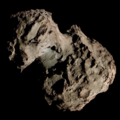 Comet Delavan photographed by Gavril A. Tikhov from the Pulkovo Observatory in October 1914 | |
| Discovery | |
|---|---|
| Discovered by | Pablo T. Delavan |
| Discovery site | La Plata Observatory |
| Discovery date | 18 December 1913 |
| Designations | |
| 1914 V, 1913f [1] | |
| Orbital characteristics [2] | |
| Epoch | 15 March 1914 (JD 2420206.5) |
| Observation arc | 628 days (1.72 years) [3] |
| Number of observations | 1,006 |
| Perihelion | 1.1044 AU |
| Eccentricity | 1.00014 |
| Inclination | 68.043° |
| 60.397° | |
| Argument of periapsis | 287.436° |
| Last perihelion | 26 October 1914 |
| Earth MOID | 0.63832 AU |
| Jupiter MOID | 1.64685 AU |
| Physical characteristics [4] [5] | |
Mean radius | 1.89 km (1.17 mi) [a] |
| Comet total magnitude (M1) | 4.8 |
| 1.1 (1914 apparition) | |
Comet Delavan, formally designated as C/1913 Y1, is a non-periodic comet discovered by astronomer Pablo T. Delavan on from the La Plata Observatory in Argentina on 18 December 1913. [3]
Contents
The comet was last seen on 19 September 1915. [6] It is one of 19 comets used in the original sample by Jan Oort for his hypothesis regarding the origin of long-period comets in 1950. [7]



